Boxing Punch Detection with Single Static Camera
Abstract
1. Introduction
2. Related Works
Motivation for the Study
3. Methodology
- Punch detecting—An approach that uses neural networks to classify frames and detect the actual moment when punches hit.
- Original image (Approach 1)—The algorithm receives the original image without any transformations.
- Colour extraction (Approach 2)—Based on the representation of the HSV [47] image model, we extract the blue and red colours of the boxers’ outfits. The outfit colours are regulated by the rules of Olympic boxing and are constant in every fight. According to these rules, a boxer must wear red or blue gloves, a head guard, and a singlet corresponding to their respective corner.
- Background subtraction (Approach 3)—The algorithm, which is based on the work in [48], removes static objects and elements from the video, leaving only objects in motion.
- Hybrid method (Approach 4)—Combining in sequence the previous two approaches: removing colours other than blue or red followed by the removal of static elements such as the floor or corners of the boxing ring.
3.1. Data Collection
3.2. Data Labelling
3.3. Public Release of Data
4. Experiments
- is the true positive, which denotes the number of frames correctly classified as a punch;
- is the true negative, which denotes the number of frames correctly classified as no punch;
- is the false positive, which denotes the incorrectly classified frames as a punch;
- is the false negative, which denotes the incorrectly classified frames as no punch;
- is the true negative ratio, defined as , also known as specificity or selectivity.
5. Statistical Analysis
6. Entropy in Boxing Punch Detection
7. Conclusions
Author Contributions
Funding
Institutional Review Board Statement
Data Availability Statement
Conflicts of Interest
References
- Garcia-Garcia, B.; Bouwmans, T.; Silva, A.J.R. Background subtraction in real applications: Challenges, current models and future directions. Comput. Sci. Rev. 2020, 35, 100204. [Google Scholar] [CrossRef]
- Barnich, O.; Droogenbroeck, M.V. ViBe: A Universal Background Subtraction Algorithm for Video Sequences. IEEE Trans. Image Process. 2011, 20, 1709–1724. [Google Scholar] [CrossRef] [PubMed]
- Wu, Y.J.; Tsai, C.M.; Shih, F. Improving Leaf Classification Rate via Background Removal and ROI Extraction. J. Image Graph. 2016, 4, 93–98. [Google Scholar] [CrossRef]
- Ni, B.; Nguyen, C.D.; Moulin, P. RGBD-camera based get-up event detection for hospital fall prevention. In Proceedings of the 2012 IEEE International Conference on Acoustics, Speech and Signal Processing (ICASSP), Kyoto, Japan, 25–30 March 2012. [Google Scholar] [CrossRef]
- Crispim, C.F.; Bathrinarayanan, V.; Fosty, B.; Konig, A.; Romdhane, R.; Thonnat, M.; Bremond, F. Evaluation of a monitoring system for event recognition of older people. In Proceedings of the 2013 10th IEEE International Conference on Advanced Video and Signal Based Surveillance, Krakow, Poland, 27–30 August 2013. [Google Scholar] [CrossRef]
- Zhou, F.; Zhao, H.; Nie, Z. Safety Helmet Detection Based on YOLOv5. In Proceedings of the 2021 IEEE International Conference on Power Electronics, Computer Applications (ICPECA), Shenyang, China, 22–24 January 2021. [Google Scholar] [CrossRef]
- Seo, J.; Han, S.; Lee, S.; Kim, H. Computer vision techniques for construction safety and health monitoring. Adv. Eng. Inform. 2015, 29, 239–251. [Google Scholar] [CrossRef]
- Li, J.; Liu, H.; Wang, T.; Jiang, M.; Wang, S.; Li, K.; Zhao, X. Safety helmet wearing detection based on image processing and machine learning. In Proceedings of the 2017 Ninth International Conference on Advanced Computational Intelligence (ICACI), Doha, Qatar, 4–6 February 2017. [Google Scholar] [CrossRef]
- Elbehiery, H.; Hefnawy, A.; Elewa, M. Surface Defects Detection for Ceramic Tiles Usingimage Processing and Morphological Techniques. 2007. Available online: https://zenodo.org/records/1084534 (accessed on 15 May 2024). [CrossRef]
- Baygin, M.; Karakose, M.; Sarimaden, A.; Erhan, A. Machine vision based defect detection approach using image processing. In Proceedings of the 2017 International Artificial Intelligence and Data Processing Symposium (IDAP), Malatya, Turkey, 16–17 September 2017. [Google Scholar] [CrossRef]
- Khasanshin, I. Application of an Artificial Neural Network to Automate the Measurement of Kinematic Characteristics of Punches in Boxing. Appl. Sci. 2021, 11, 1223. [Google Scholar] [CrossRef]
- Quinn, E.; Corcoran, N. Automation of Computer Vision Applications for Real-time Combat Sports Video Analysis. Eur. Conf. Impact Artif. Intell. Robot. 2022, 4, 162–171. [Google Scholar] [CrossRef]
- Kato, S.; Yamagiwa, S. Predicting Successful Throwing Technique in Judo from Factors of Kumite Posture Based on a Machine-Learning Approach. Computation 2022, 10, 175. [Google Scholar] [CrossRef]
- Ye, X.; Shi, B.; Li, M.; Fan, Q.; Qi, X.; Liu, X.; Zhao, S.; Jiang, L.; Zhang, X.; Fu, K.; et al. All-textile sensors for boxing punch force and velocity detection. Nano Energy 2022, 97, 107114. [Google Scholar] [CrossRef]
- Hahn, A.; Helmer, R.; Kelly, T.; Partridge, K.; Krajewski, A.; Blanchonette, I.; Barker, J.; Bruch, H.; Brydon, M.; Hooke, N.; et al. Development of an automated scoring system for amateur boxing. Procedia Eng. 2010, 2, 3095–3101. [Google Scholar] [CrossRef]
- Worsey, M.T.O.; Espinosa, H.G.; Shepherd, J.B.; Thiel, D.V. An Evaluation of Wearable Inertial Sensor Configuration and Supervised Machine Learning Models for Automatic Punch Classification in Boxing. IoT 2020, 1, 360–381. [Google Scholar] [CrossRef]
- Worsey, M.; Espinosa, H.; Shepherd, J.; Thiel, D. Inertial Sensors for Performance Analysis in Combat Sports: A Systematic Review. Sports 2019, 7, 28. [Google Scholar] [CrossRef] [PubMed]
- Kasiri-Bidhendi, S.; Fookes, C.; Morgan, S.; Martin, D.T.; Sridharan, S. Combat sports analytics: Boxing punch classification using overhead depthimagery. In Proceedings of the 2015 IEEE International Conference on Image Processing (ICIP), Quebec City, QC, Canada, 27–30 September 2015. [Google Scholar] [CrossRef]
- Kasiri, S.; Fookes, C.; Sridharan, S.; Morgan, S. Fine-grained action recognition of boxing punches from depth imagery. Comput. Vis. Image Underst. 2017, 159, 143–153. [Google Scholar] [CrossRef]
- Behendi, S.K.; Morgan, S.; Fookes, C.B. Non-Invasive Performance Measurement in Combat Sports. In Proceedings of the 10th International Symposium on Computer Science in Sports (ISCSS); Springer International Publishing: Cham, Switzerland, 2015; pp. 3–10. [Google Scholar] [CrossRef]
- Wattanamongkhol, N.; Kumhom, P.; Chamnongthai, K. A method of glove tracking for amateur boxing refereeing. In Proceedings of the IEEE International Symposium on Communications and Information Technology, ISCIT 2005, Beijing, China, 12–14 October 2005. [Google Scholar] [CrossRef]
- Jia, W.; Xu, S.; Liang, Z.; Zhao, Y.; Min, H.; Li, S.; Yu, Y. Real-time automatic helmet detection of motorcyclists in urban traffic using improved YOLOv5 detector. IET Image Process. 2021, 15, 3623–3637. [Google Scholar] [CrossRef]
- Wu, Z.; Radke, R.J. Real-time airport security checkpoint surveillance using a camera network. In Proceedings of the CVPR 2011 WORKSHOPS, Colorado Springs, CO, USA, 20–25 June 2011. [Google Scholar] [CrossRef]
- Braun, M.; Krebs, S.; Flohr, F.; Gavrila, D.M. EuroCity Persons: A Novel Benchmark for Person Detection in Traffic Scenes. IEEE Trans. Pattern Anal. Mach. Intell. 2019, 41, 1844–1861. [Google Scholar] [CrossRef]
- Dollar, P.; Wojek, C.; Schiele, B.; Perona, P. Pedestrian Detection: An Evaluation of the State of the Art. IEEE Trans. Pattern Anal. Mach. Intell. 2012, 34, 743–761. [Google Scholar] [CrossRef] [PubMed]
- Ragesh, N.K.; Rajesh, R. Pedestrian Detection in Automotive Safety: Understanding State-of-the-Art. IEEE Access 2019, 7, 47864–47890. [Google Scholar] [CrossRef]
- Wu, J.; Chen, F.; Hu, D. Human Interaction Recognition by Spatial Structure Models. In Lecture Notes in Computer Science; Springer: Berlin/Heidelberg, Germany, 2013; pp. 216–222. [Google Scholar] [CrossRef]
- Malgireddy, M.R.; Inwogu, I.; Govindaraju, V. A temporal Bayesian model for classifying, detecting and localizing activities in video sequences. In Proceedings of the 2012 IEEE Computer Society Conference on Computer Vision and Pattern Recognition Workshops, Providence, RI, USA, 16–21 June 2012. [Google Scholar] [CrossRef]
- Alfaro, A.; Mery, D.; Soto, A. Human Action Recognition from Inter-temporal Dictionaries of Key-Sequences. In Image and Video Technology; Springer: Berlin/Heidelberg, Germany, 2014; pp. 419–430. [Google Scholar] [CrossRef]
- Patron-Perez, A.; Marszalek, M.; Reid, I.; Zisserman, A. Structured Learning of Human Interactions in TV Shows. IEEE Trans. Pattern Anal. Mach. Intell. 2012, 34, 2441–2453. [Google Scholar] [CrossRef] [PubMed]
- Chen, C.; Liu, M.Y.; Tuzel, O.; Xiao, J. R-CNN for Small Object Detection. In Computer Vision—ACCV 2016; Springer International Publishing: Berlin/Heidelberg, Germany, 2017; pp. 214–230. [Google Scholar] [CrossRef]
- Kisantal, M.; Wojna, Z.; Murawski, J.; Naruniec, J.; Cho, K. Augmentation for small object detection. arXiv 2019, arXiv:1902.07296. [Google Scholar] [CrossRef]
- Thomas, G.; Gade, R.; Moeslund, T.B.; Carr, P.; Hilton, A. Computer vision for sports: Current applications and research topics. Comput. Vis. Image Underst. 2017, 159, 3–18. [Google Scholar] [CrossRef]
- Leo, M.; D’Orazio, T.; Trivedi, M. A multi camera system for soccer player performance evaluation. In Proceedings of the 2009 Third ACM/IEEE International Conference on Distributed Smart Cameras (ICDSC), Como, Italy, 30 August 2009–2 September 2009. [Google Scholar] [CrossRef]
- Setterwall, D. Computerised Video Analysis of Football—Technical and Commercial Possibilitiesfor Football Coaching. Master’s Thesis, Stockholms Universitet, Stockholm, Sweden, 2003, unpublished. [Google Scholar]
- Sudhir, G.; Lee, J.; Jain, A. Automatic classification of tennis video for high-level content-based retrieval. In Proceedings of the Proceedings 1998 IEEE International Workshop on Content-Based Access of Image and Video Database, Bombay, India, 3 January 1998. [Google Scholar] [CrossRef]
- Stein, M.; Janetzko, H.; Lamprecht, A.; Breitkreutz, T.; Zimmermann, P.; Goldlucke, B.; Schreck, T.; Andrienko, G.; Grossniklaus, M.; Keim, D.A. Bring It to the Pitch: Combining Video and Movement Data to Enhance Team Sport Analysis. IEEE Trans. Vis. Comput. Graph. 2018, 24, 13–22. [Google Scholar] [CrossRef]
- Buric, M.; Pobar, M.; Ivasic-Kos, M. Object detection in sports videos. In Proceedings of the 2018 41st International Convention on Information and Communication Technology, Electronics and Microelectronics (MIPRO), Opatija, Croatia, 21–25 May 2018. [Google Scholar] [CrossRef]
- Jeffries, C.T. Sports Analytics with Computer Vision. Senior Independent Study Theses. Paper 8103. 2018. Available online: https://openworks.wooster.edu/independentstudy/8103 (accessed on 15 May 2024).
- Pettersen, S.A.; Halvorsen, P.; Johansen, D.; Johansen, H.; Berg-Johansen, V.; Gaddam, V.R.; Mortensen, A.; Langseth, R.; Griwodz, C.; Stensland, H.K. Soccer video and player position dataset. In Proceedings of the 5th ACM Multimedia Systems Conference on—MMSys ’14, Singapore, 19 March 2014; ACM Press: New York, NY, USA, 2014. [Google Scholar] [CrossRef]
- Johnson, S.; Everingham, M. Clustered Pose and Nonlinear Appearance Models for Human Pose Estimation. In Proceedings of the British Machine Vision Conference 2010, Aberystwyth, UK, 31 August–3 September 2010; British Machine Vision Association: Durham, UK, 2010. [Google Scholar]
- Leo, M.; Mosca, N.; Spagnolo, P.; Mazzeo, P.L.; D’Orazio, T.; Distante, A. Real-time multiview analysis of soccer matches for understanding interactions between ball and players. In Proceedings of the 2008 International Conference on Content-Based Image and Video Retrieval—CIVR’08, New York, NY, USA, 7–9 July 2008; ACM Press: New York, NY, USA, 2008. [Google Scholar] [CrossRef]
- Stefański, P.; Kozak, J.; Jach, T. The Problem of Detecting Boxers in the Boxing Ring. In Proceedings of the Recent Challenges in Intelligent Information and Database Systems: 14th Asian Conference, ACIIDS 2022, Ho Chi Minh City, Vietnam, 28–30 November 2022; Springer: Berlin/Heidelberg, Germany, 2022; pp. 592–603. [Google Scholar] [CrossRef]
- Stefański, P. Detecting Clashes in Boxing. In Proceedings of the 3rd Polish Conference on Artificial Intelligence, Gdynia, Poland, 25–27 April 2022; pp. 29–32. [Google Scholar]
- Fang, W.; Ding, Y.; Zhang, F.; Sheng, V.S. DOG: A new background removal for object recognition from images. Neurocomputing 2019, 361, 85–91. [Google Scholar] [CrossRef]
- Kim, C.; Lee, J.; Han, T.; Kim, Y.M. A hybrid framework combining background subtraction and deep neural networks for rapid person detection. J. Big Data 2018, 5, 22. [Google Scholar] [CrossRef]
- Kolkur, S.; Kalbande, D.; Shimpi, P.; Bapat, C.; Jatakia, J. Human Skin Detection Using RGB, HSV and YCbCr Color Models. arXiv 2017, arXiv:1708.02694. [Google Scholar] [CrossRef]
- Zivkovic, Z. Improved adaptive Gaussian mixture model for background subtraction. In Proceedings of the 17th International Conference on Pattern Recognition, 2004, ICPR 2004, Cambridge, UK, 26 August 2004. [Google Scholar] [CrossRef]
- Stefański, P.; Kozak, J. Olympic Boxing Punch Classification Video Dataset. 2024. Available online: https://www.kaggle.com/datasets/piotrstefaskiue/olympic-boxing-punch-classification-video-dataset (accessed on 17 June 2024).
- Leonard, J.K. Theory and Problems of Business Statstics; McGraw-Hill: New York, NY, USA, 2004. [Google Scholar]
- Friedman, M. The use of ranks to avoid the assumption of normality implicit in the analysis of variance. J. Am. Stat. Assoc. 1937, 32, 675–701. [Google Scholar] [CrossRef]
- Kanji, G.K. 100 Statistical Tests; Sage: Newcastle upon Tyne, UK, 2006. [Google Scholar]


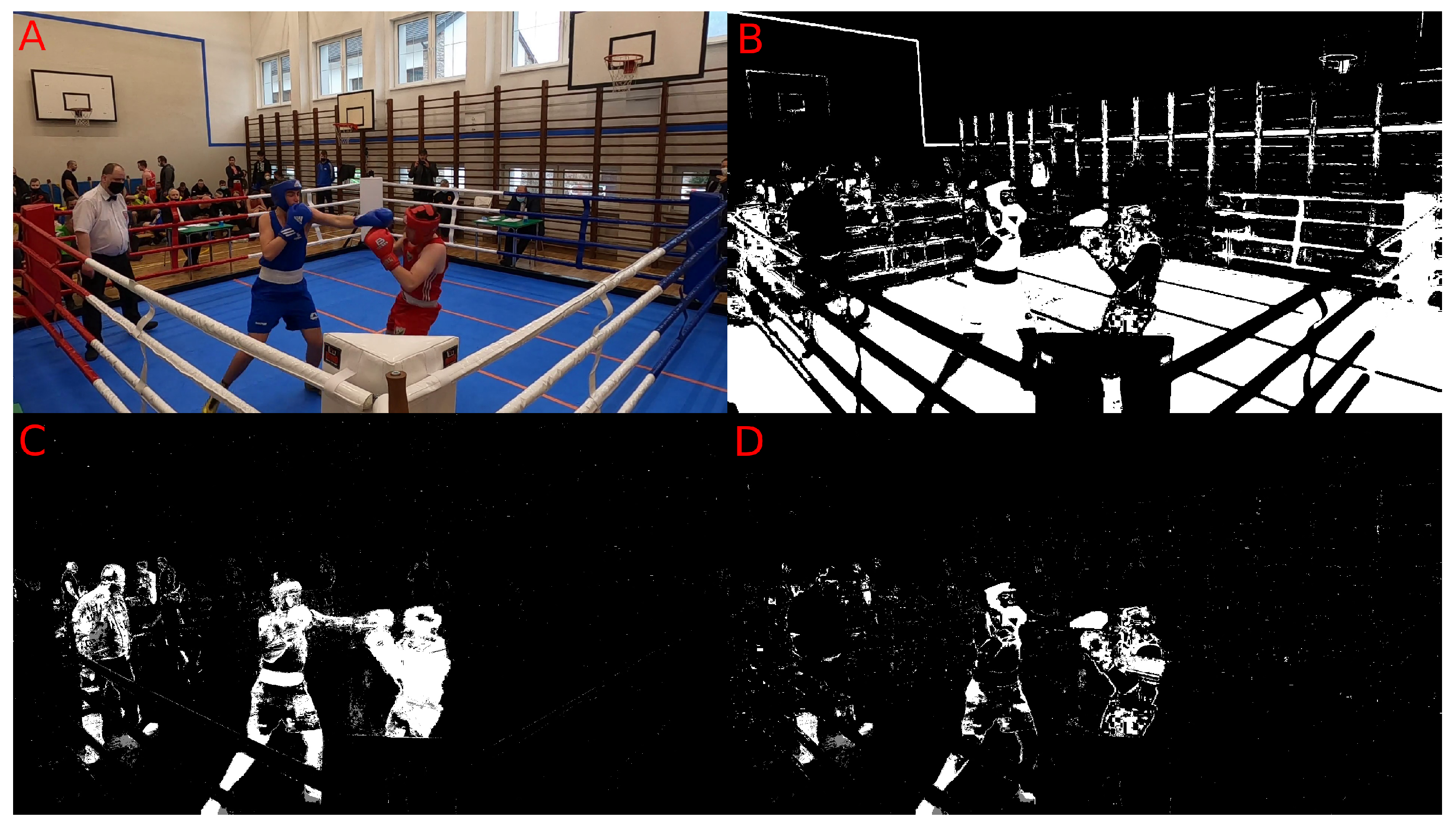
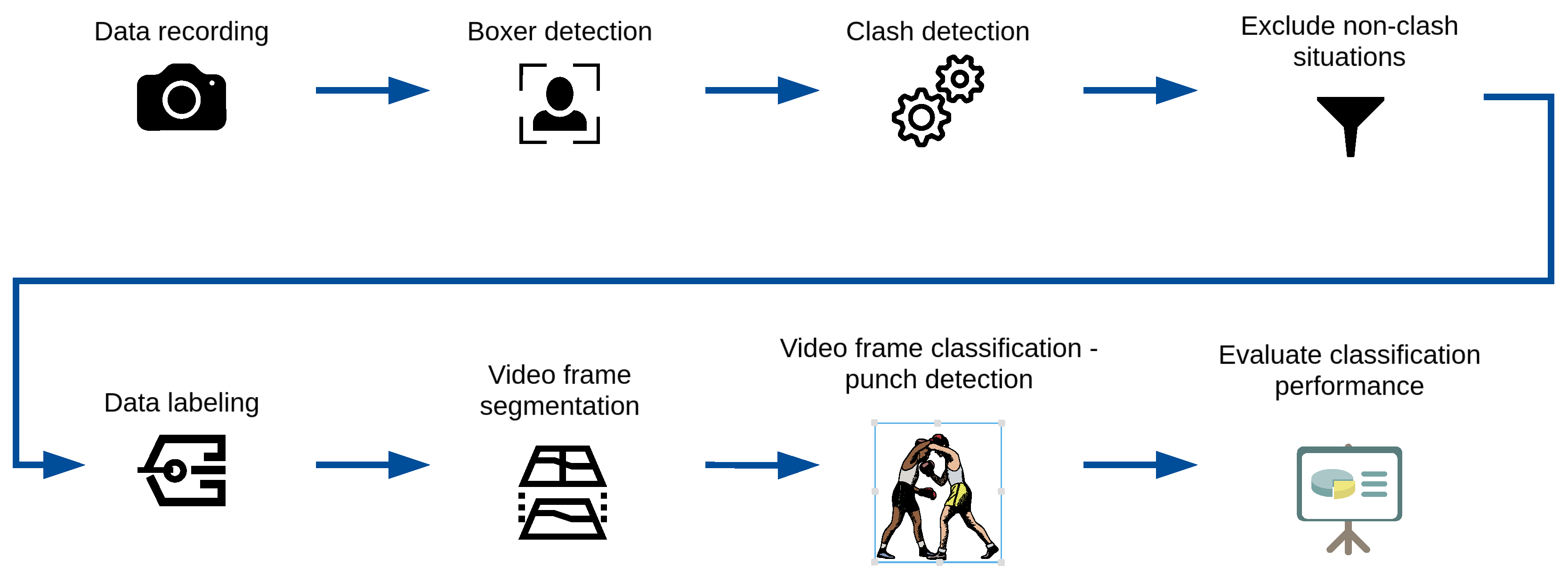
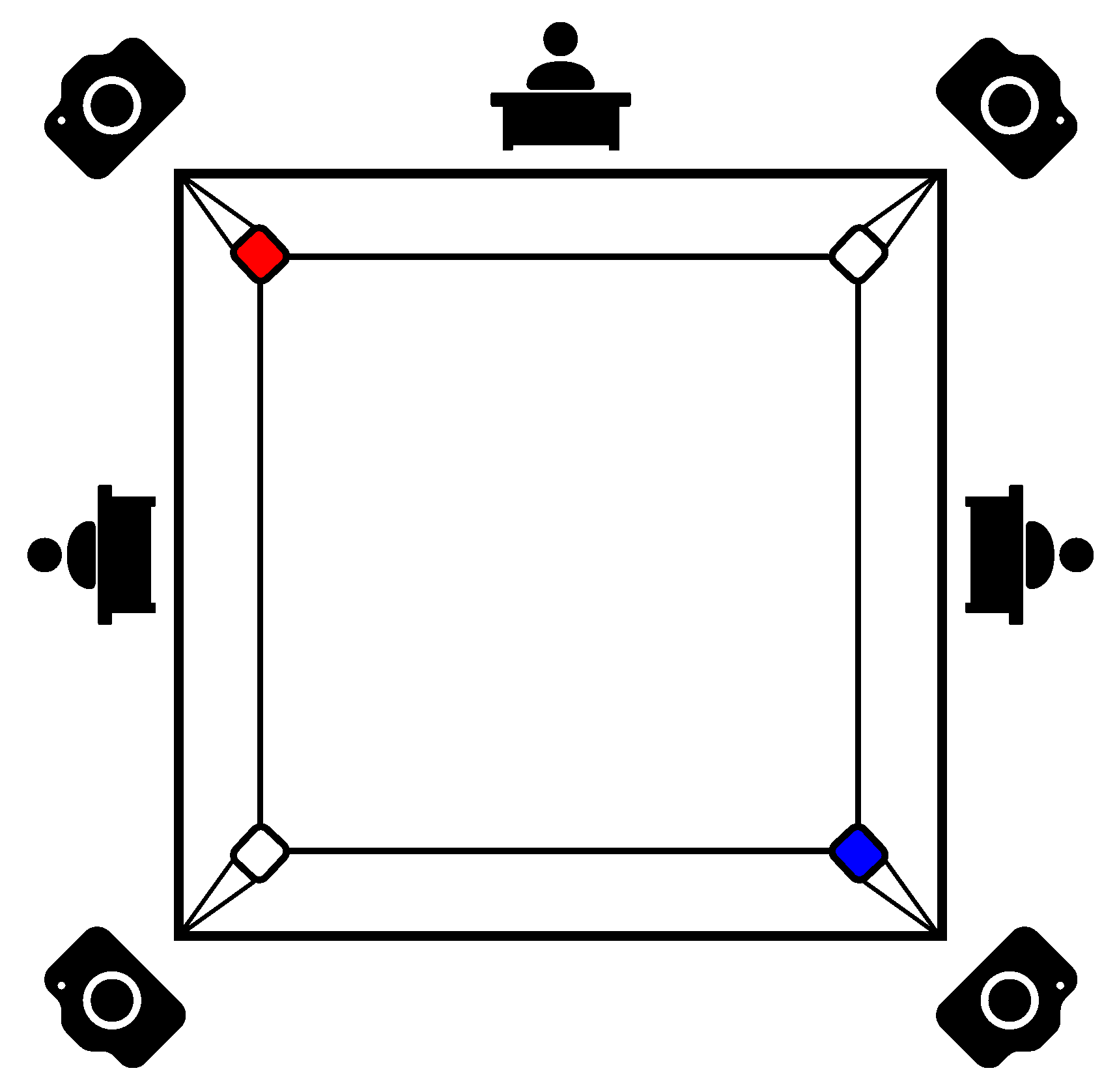
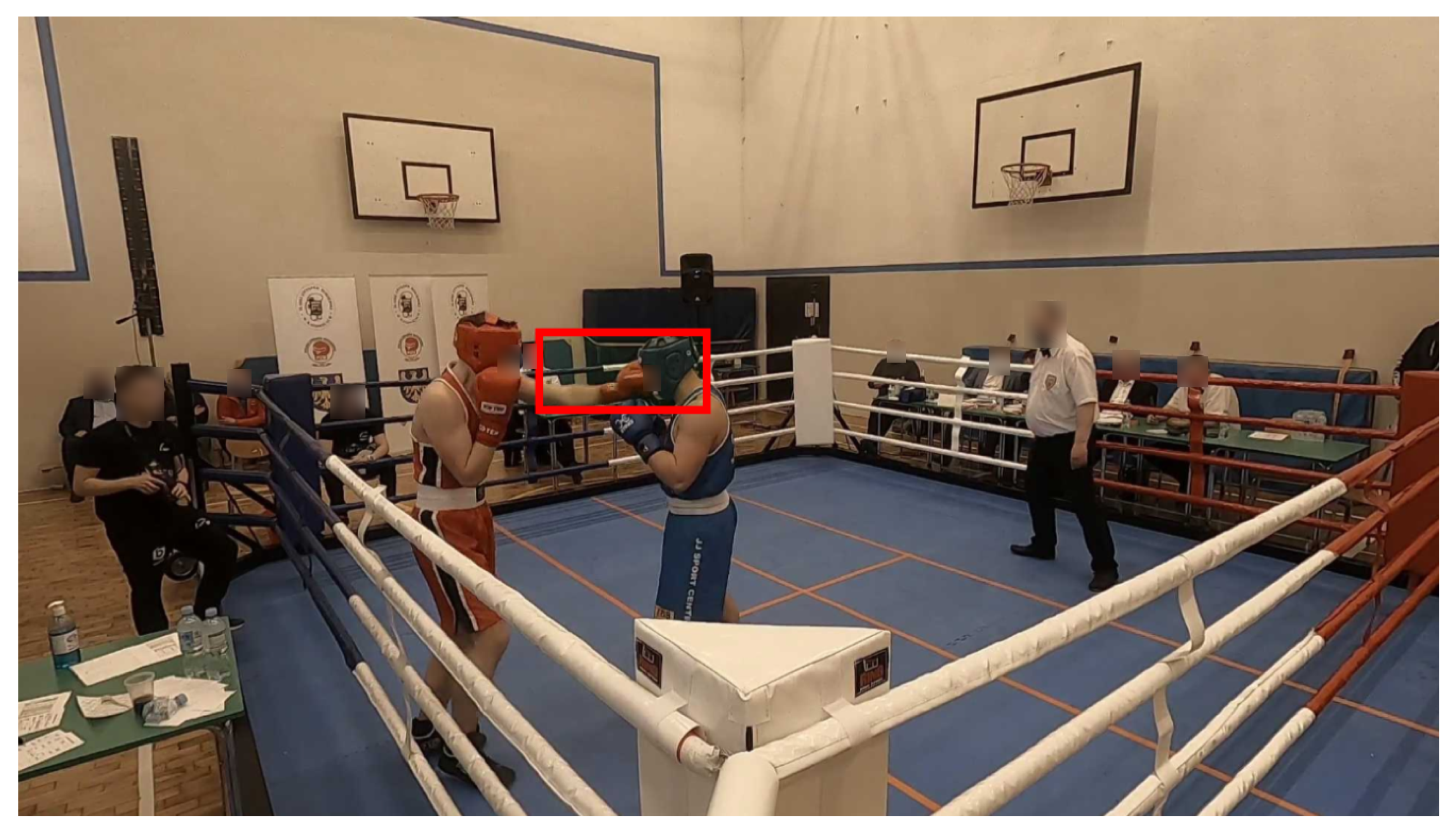
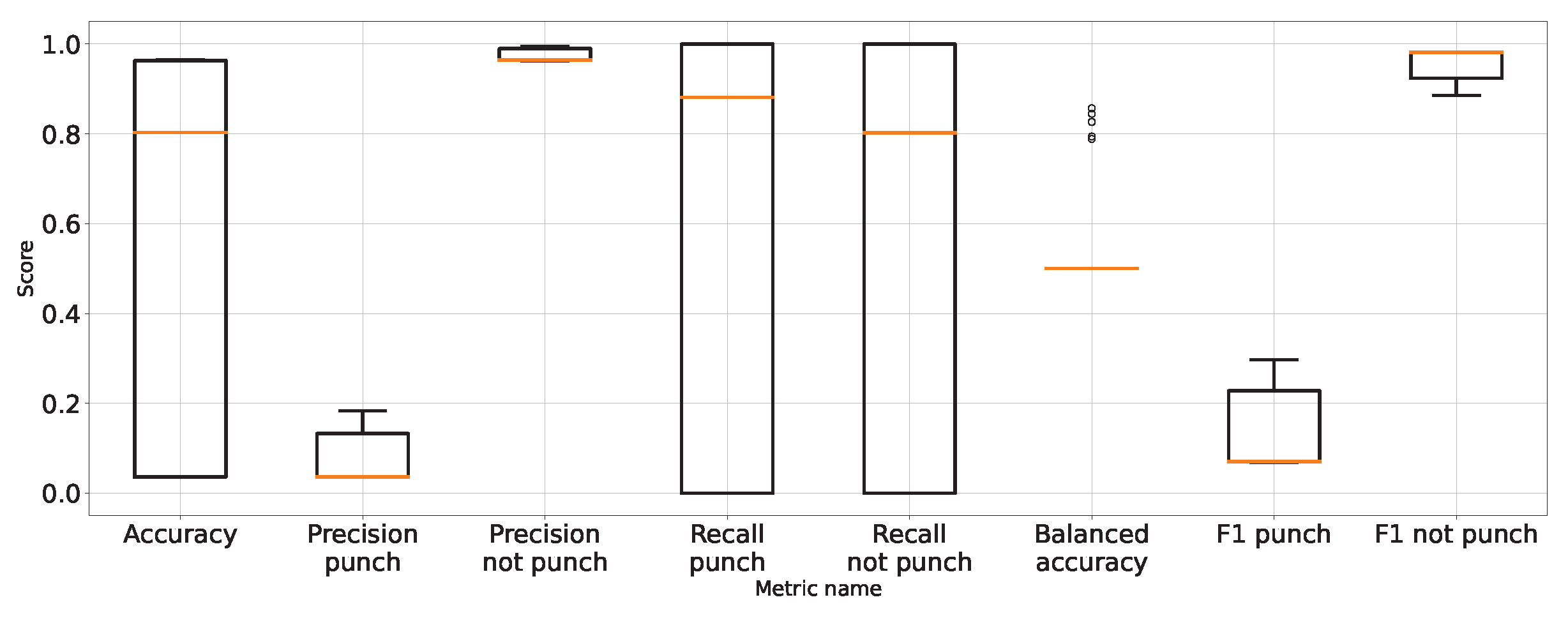

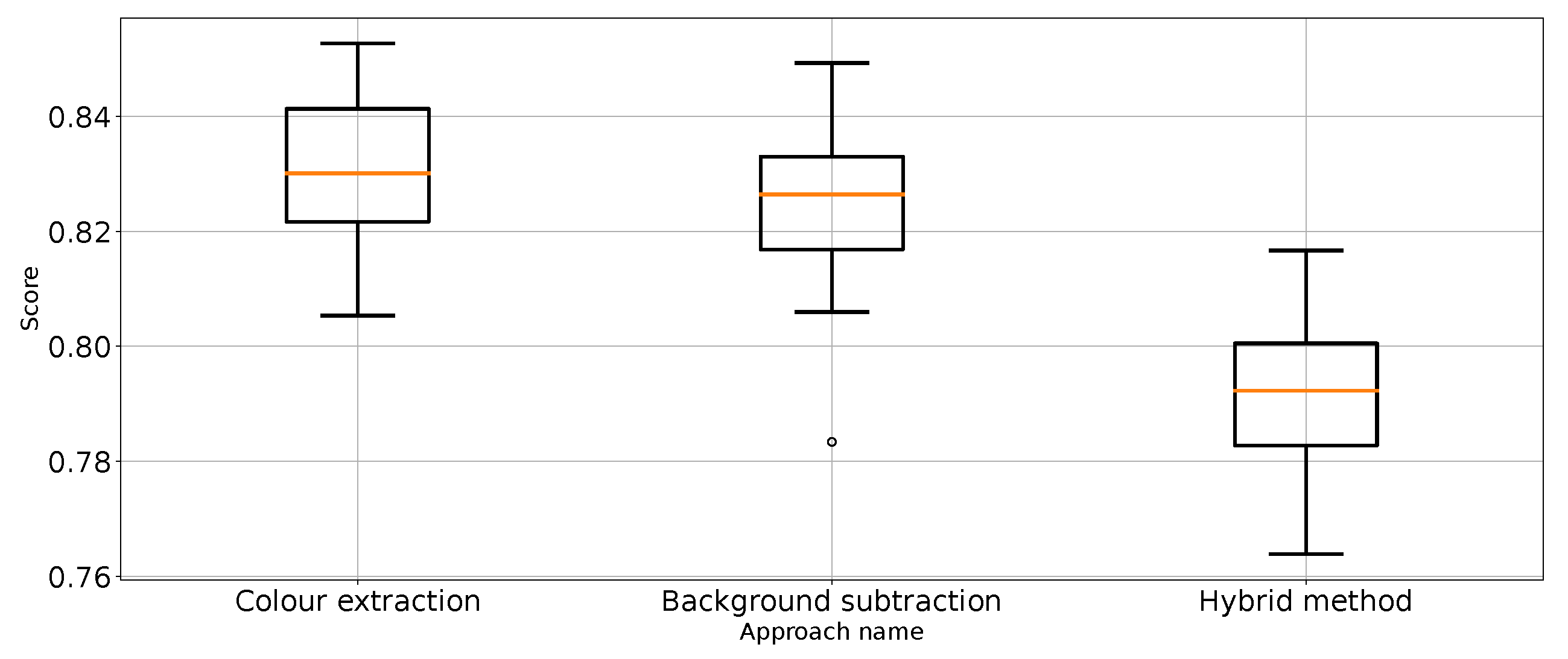
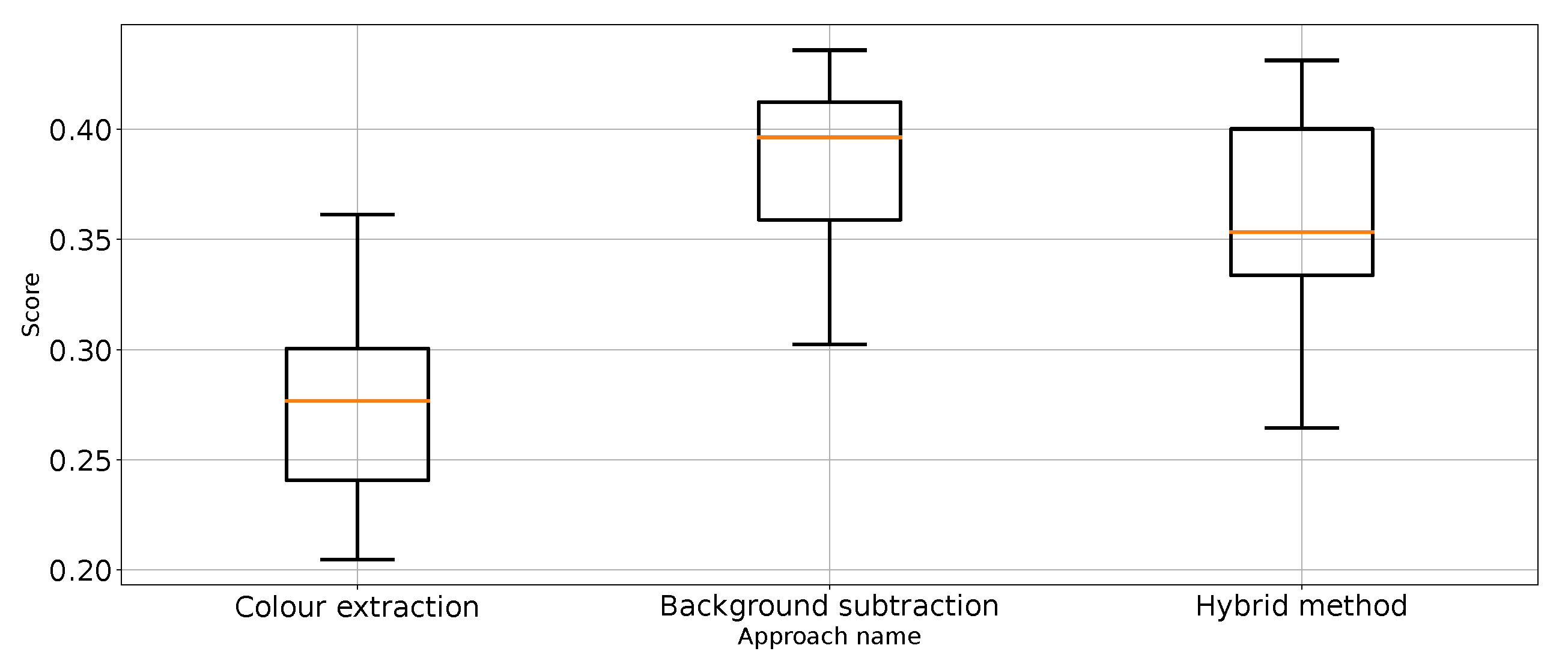
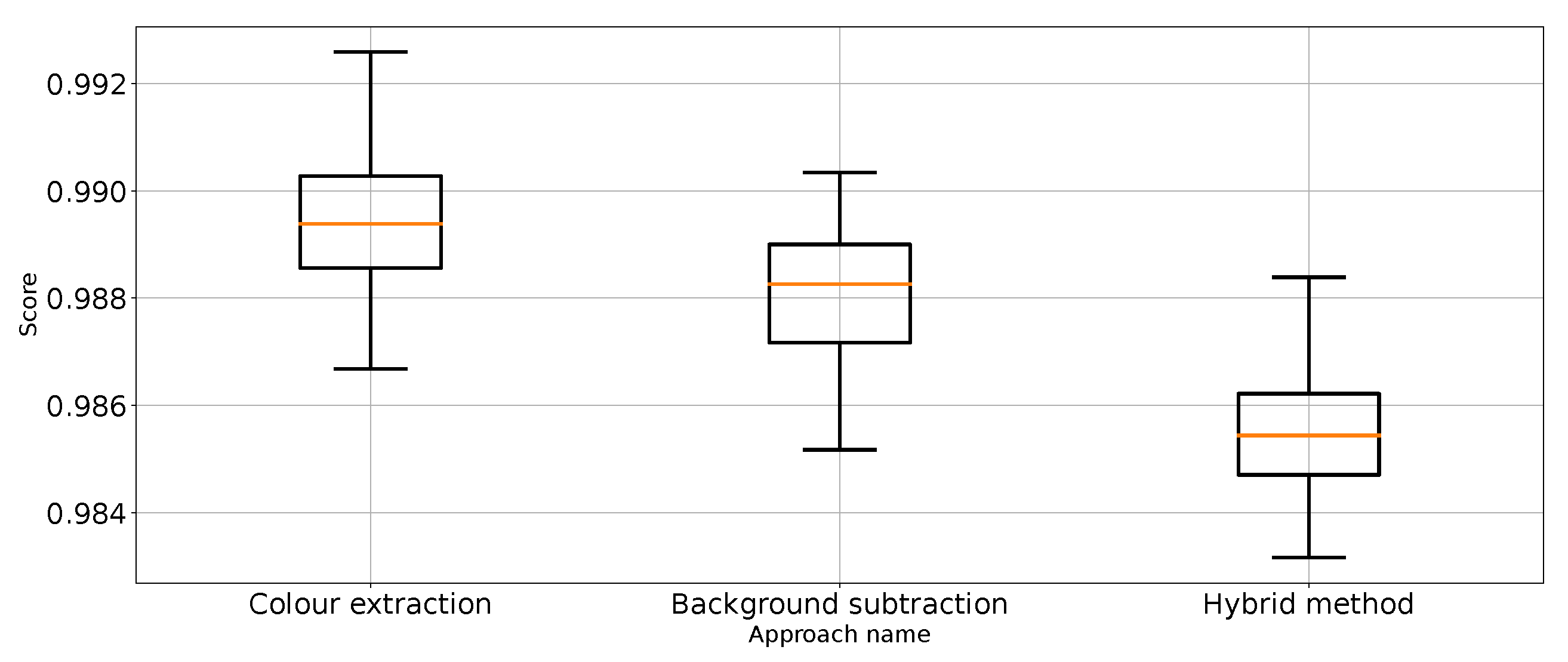
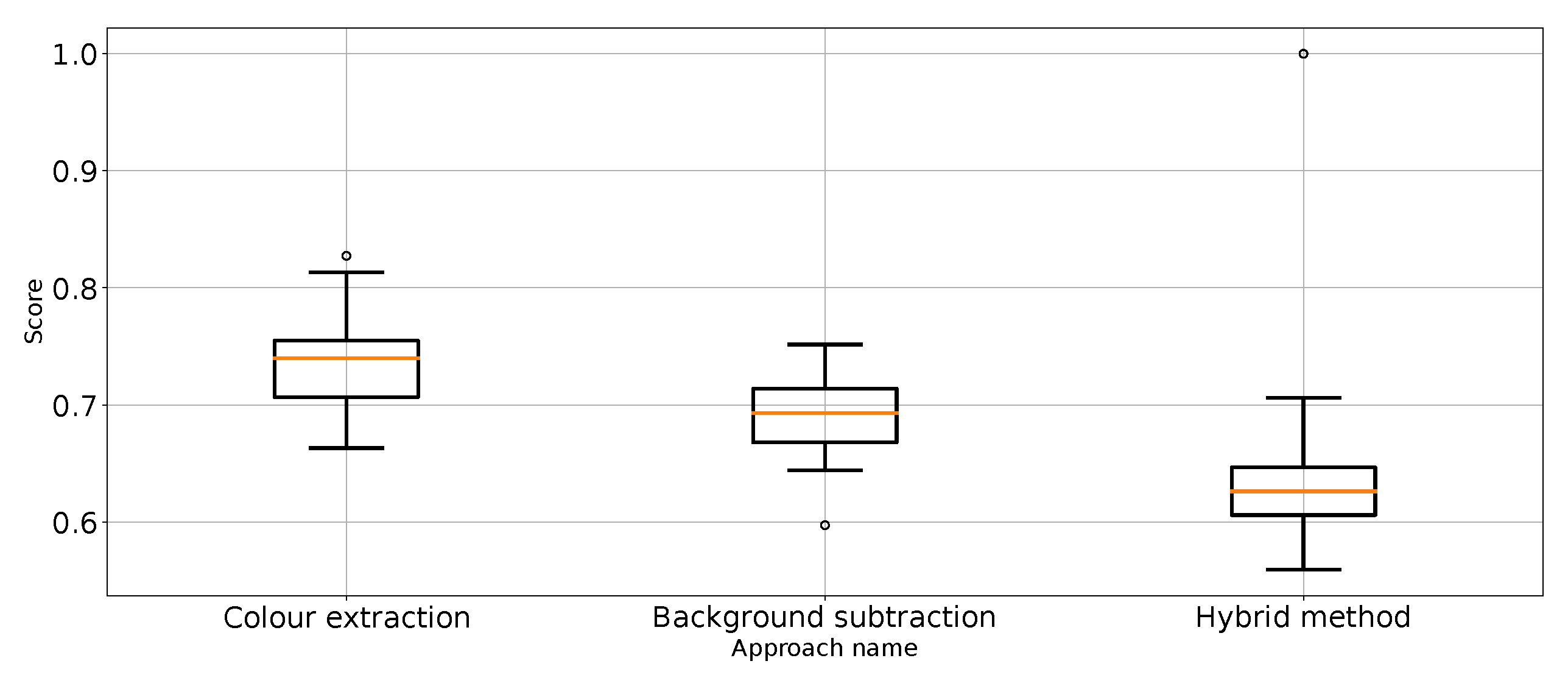
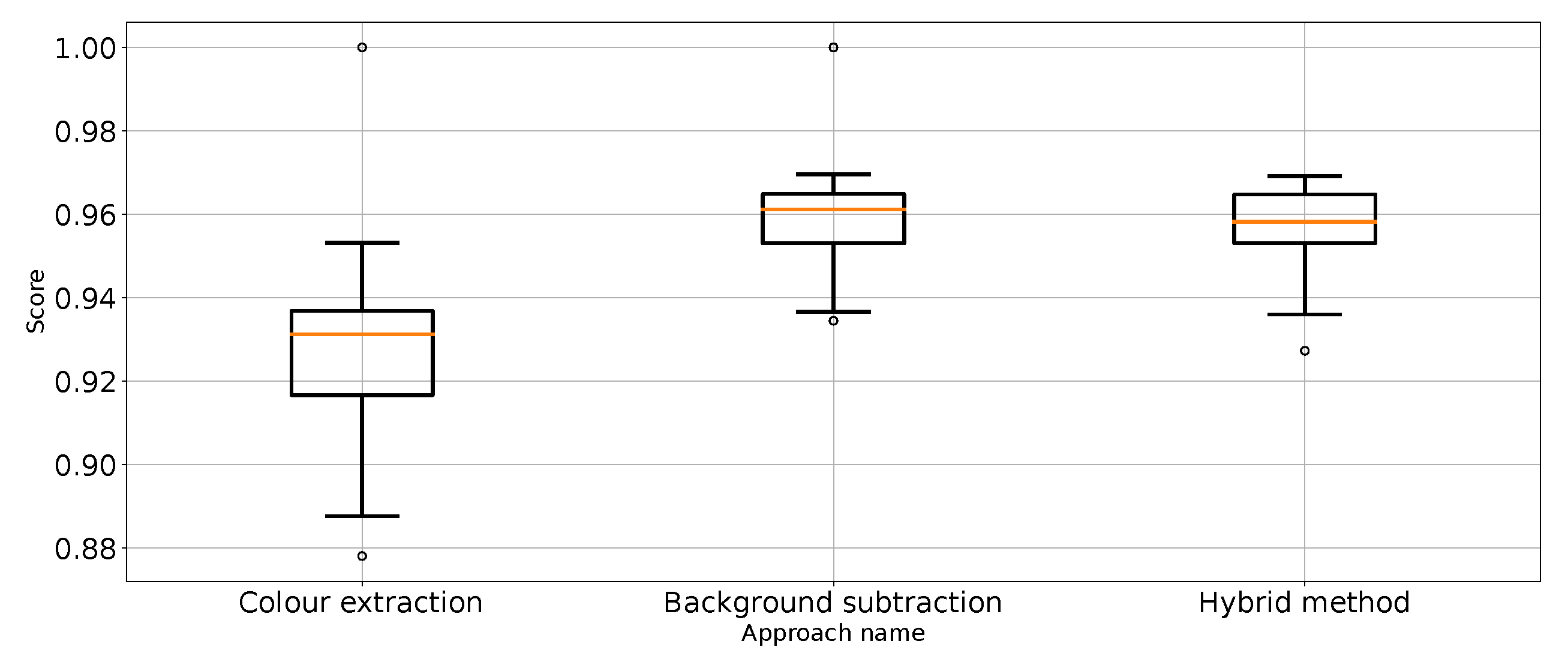
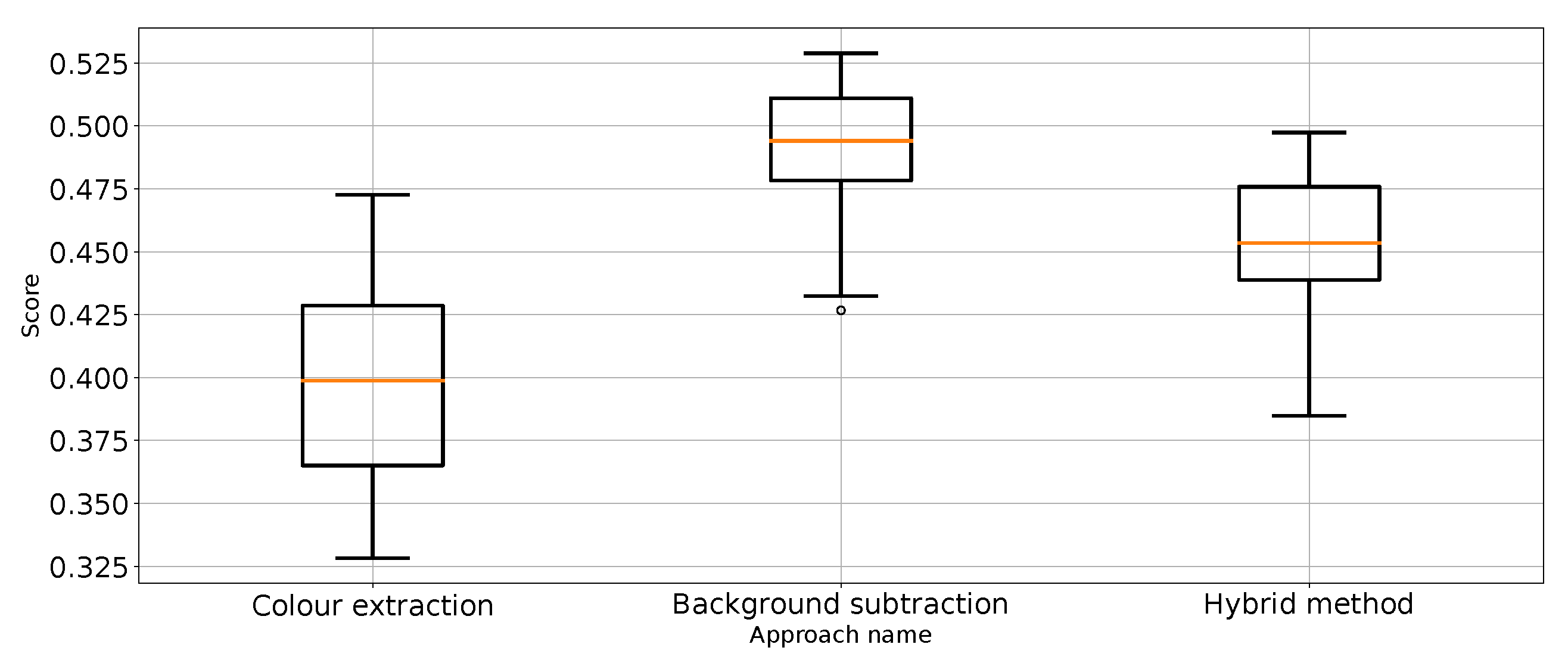
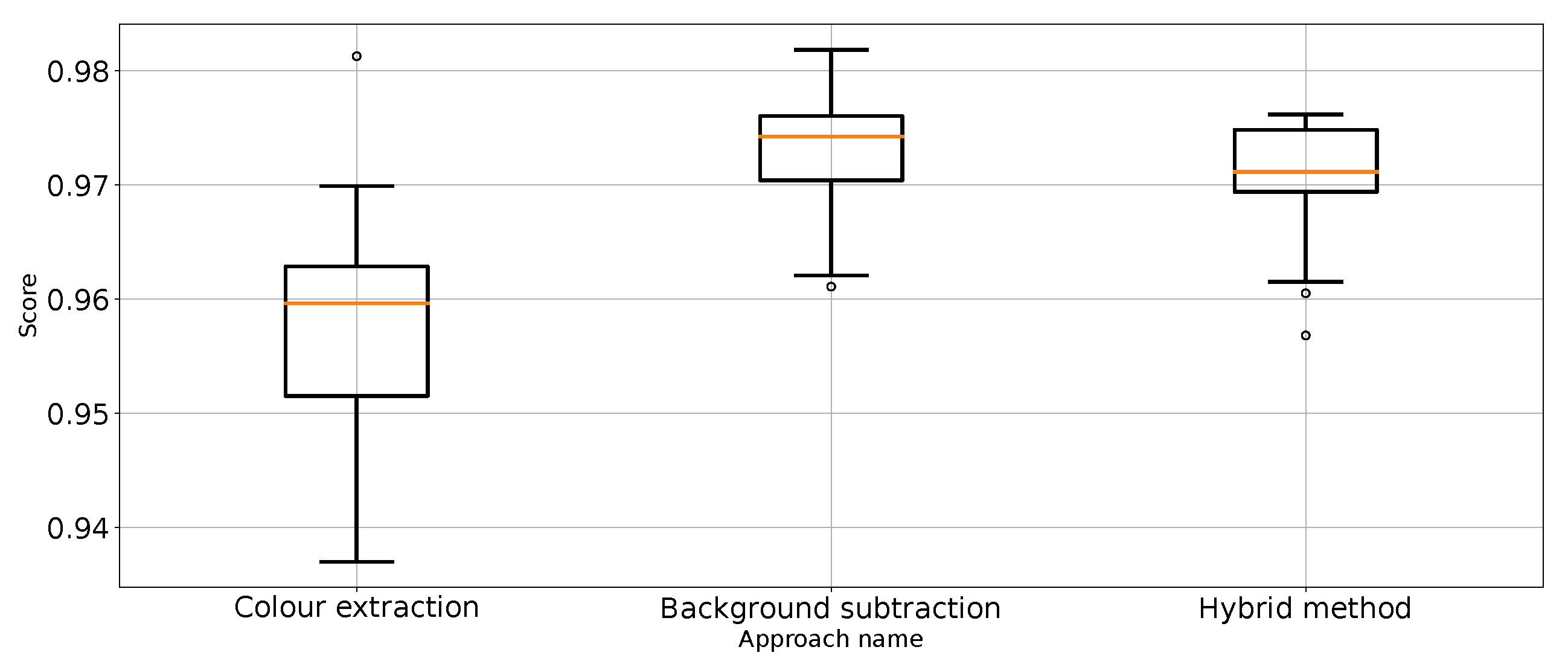
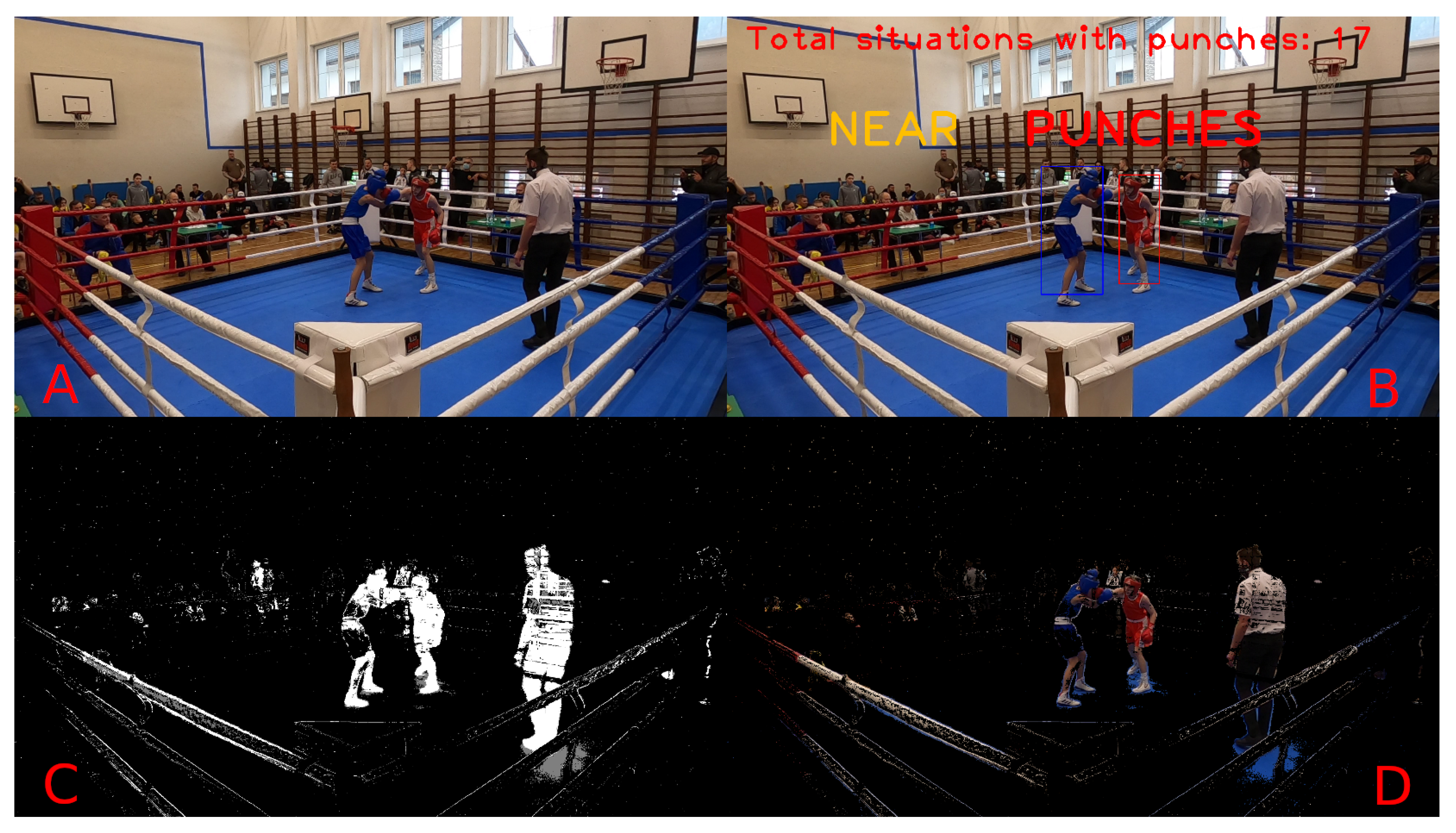
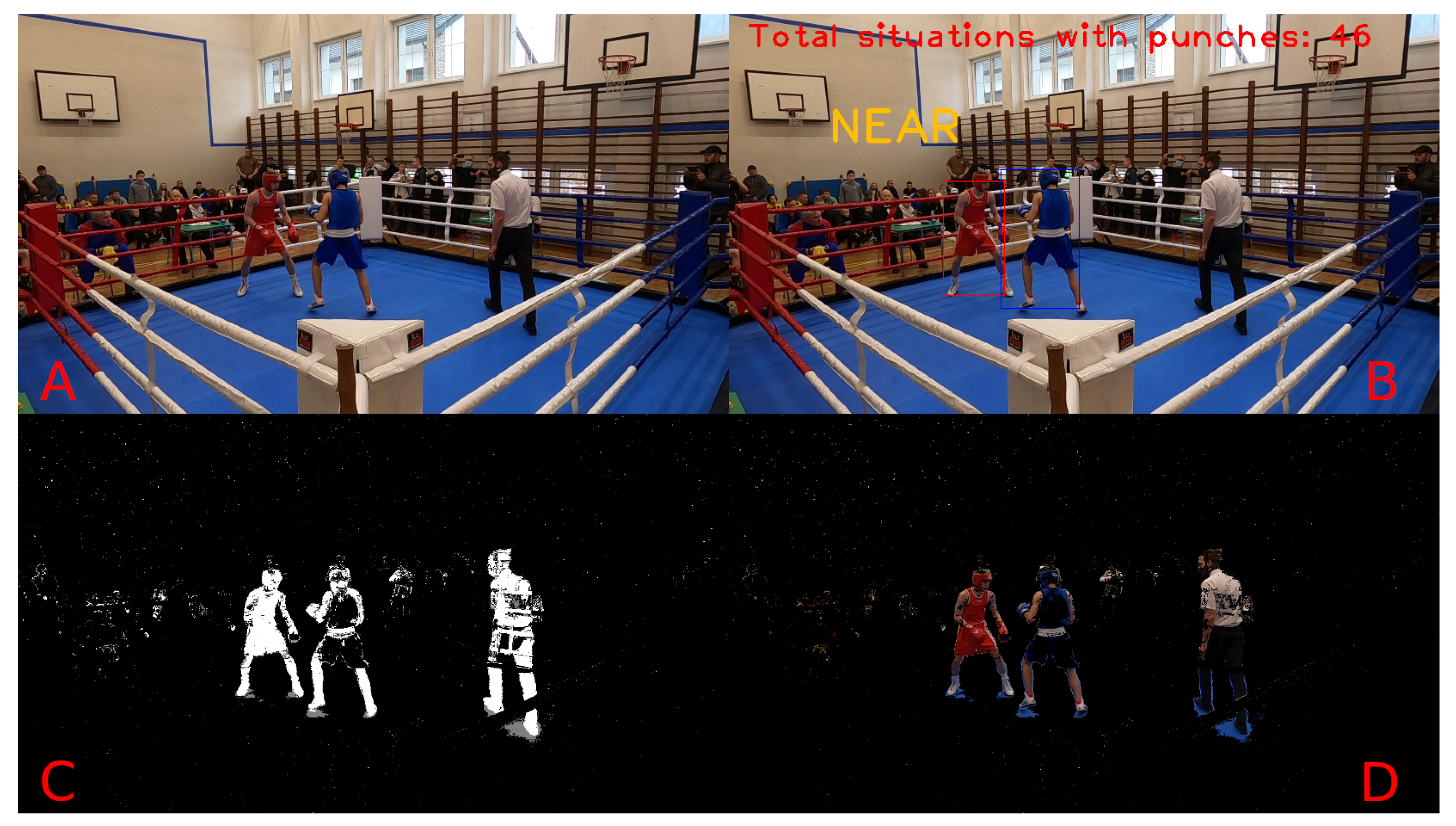
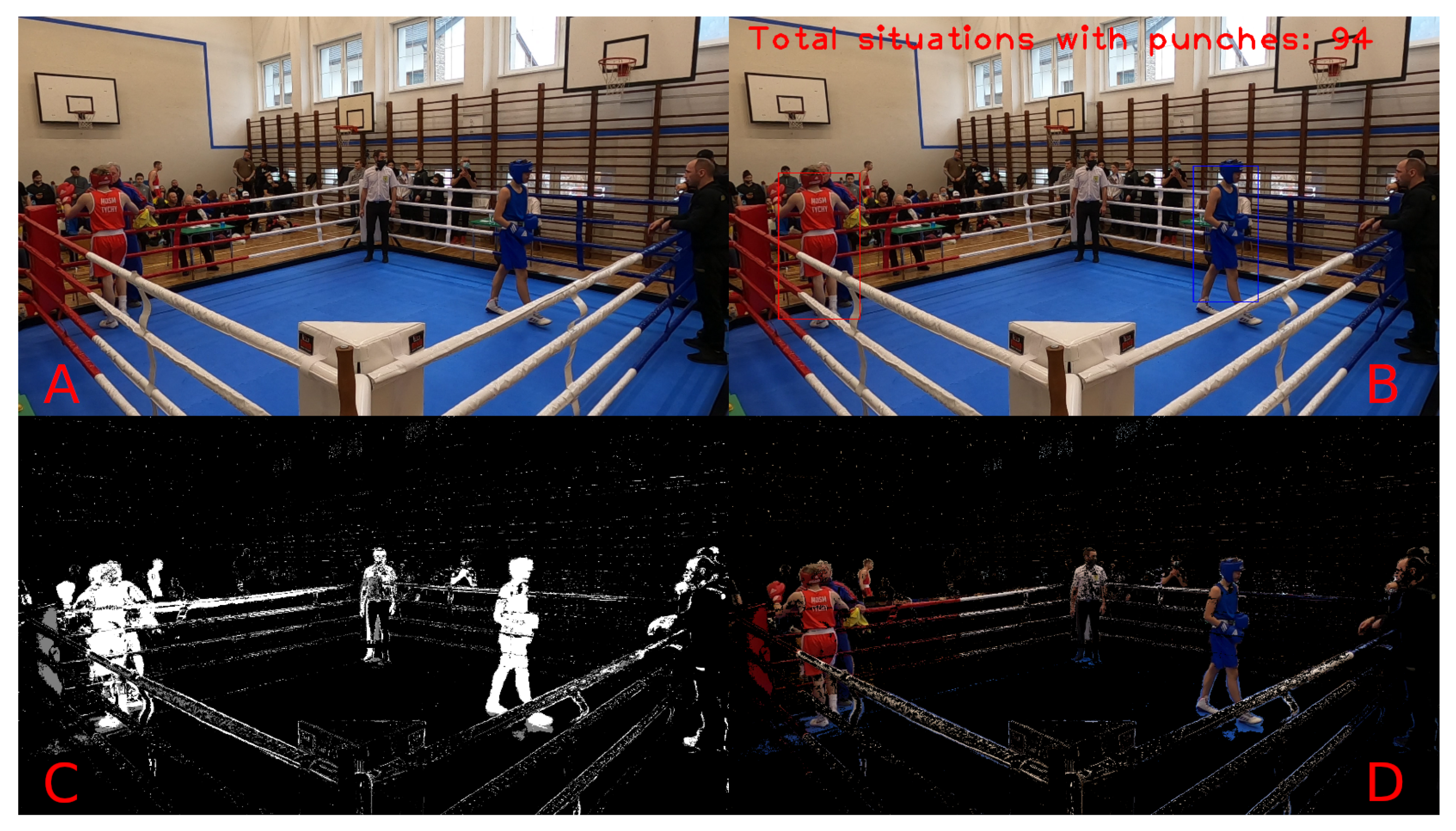
| Metric | Apr. 1 | Apr. 2 | Apr. 3 | Apr. 4 |
|---|---|---|---|---|
| Accuracy | 0.8033 | 0.9240 | 0.9502 | 0.9449 |
| Balanced accuracy | 0.5000 | 0.8299 | 0.8257 | 0.7922 |
| Precision punch | 0.0364 | 0.2767 | 0.3899 | 0.3529 |
| Precision not punch | 0.9643 | 0.9893 | 0.9882 | 0.9854 |
| Recall punch | 0.8808 | 0.7377 | 0.6935 | 0.6260 |
| Recall not punch | 0.8023 | 0.9311 | 0.9600 | 0.9578 |
| F1 punch | 0.0703 | 0.3987 | 0.4932 | 0.4495 |
| F1 no punch | 0.9812 | 0.9594 | 0.9738 | 0.9711 |
| Metric | Apr. 1 | Apr. 2 | Apr. 3 | Apr. 4 |
|---|---|---|---|---|
| TN | 1965.500 | 1664.000 | 1560.500 | 1428.000 |
| FP | 266.000 | 597.000 | 690.500 | 848.500 |
| FN | 11,922.500 | 4151.500 | 2345.000 | 2539.500 |
| TP | 48,387.000 | 56,154.000 | 57,969.000 | 57,721.500 |
| Metric | Apr. 2 | Apr. 3 | Apr. 4 |
|---|---|---|---|
| Time (s) | 161.115 | 272.234 | 356.519 |
| CPU avg (%) | 37.438 | 82.387 | 66.852 |
| Mem avg (%) | 72.593 | 63.760 | 70.404 |
| Values | |
| N | 8 |
| Chi-Square | 6.4500 |
| Degrees of Freedom | 3 |
| p Value is Less Than | 0.0917 |
| 5% Critical Difference | 1.2274 |
| Mean Ranks | |
| Approach 1 | 3.2500 |
| Approach 2 | 2.5000 |
| Approach 3 | 1.6250 |
| Approach 4 | 2.6250 |
Disclaimer/Publisher’s Note: The statements, opinions and data contained in all publications are solely those of the individual author(s) and contributor(s) and not of MDPI and/or the editor(s). MDPI and/or the editor(s) disclaim responsibility for any injury to people or property resulting from any ideas, methods, instructions or products referred to in the content. |
© 2024 by the authors. Licensee MDPI, Basel, Switzerland. This article is an open access article distributed under the terms and conditions of the Creative Commons Attribution (CC BY) license (https://creativecommons.org/licenses/by/4.0/).
Share and Cite
Stefański, P.; Kozak, J.; Jach, T. Boxing Punch Detection with Single Static Camera. Entropy 2024, 26, 617. https://doi.org/10.3390/e26080617
Stefański P, Kozak J, Jach T. Boxing Punch Detection with Single Static Camera. Entropy. 2024; 26(8):617. https://doi.org/10.3390/e26080617
Chicago/Turabian StyleStefański, Piotr, Jan Kozak, and Tomasz Jach. 2024. "Boxing Punch Detection with Single Static Camera" Entropy 26, no. 8: 617. https://doi.org/10.3390/e26080617
APA StyleStefański, P., Kozak, J., & Jach, T. (2024). Boxing Punch Detection with Single Static Camera. Entropy, 26(8), 617. https://doi.org/10.3390/e26080617







